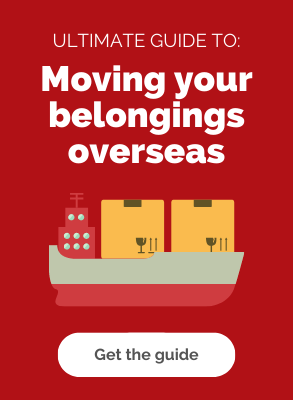Are you relocating for work? Is your employer providing you a lump sum removals budget for moving your household goods? or do you have a set removals budget you've saved for your move? Here's our top tips on how to make the most of it.
One of the really common questions we get is “what’s the cheapest way of moving for the things I’ve got?” so this article explains how to make the most of your budget using some tips for reducing your overall volume and the different methods available from removal companies for sending your household goods overseas and the pros and cons of each to help you identify which suits you best.
1 - Choose the most cost effective transport option that meets your needs
Most international shipping and moving companies will offer a range of services to meet your needs regarding size of shipment, how quickly you need it and how much your budget is to spend on removals. These tend to fall into the following categories, although some movers may call them different things or offer variations or specialist services within each:
Full / Exclusive Container Load
Depending on the volume of your belongings they will be loaded within an exclusive use 20, 40 or 45 foot steel container which will be sealed and transported to the port for shipping to your destination. At destination the container will be customs cleared, delivered and unloaded at your residence. This service is direct therefore provides the quickest transit time so is ideal if you have a larger volume of goods (A 20ft container is about the size of a single garage and typically enough for the belongings of an average 3 bedroom house – if there is such a thing as average!)
Shared Containers
If you are moving a smaller volume of belongings most moving companies offer shared container services whereby you share the space in a shipping container with other customers moving to the same destination.
This is a cost effective method of shipping for smaller consignments as you only pay for the space you use, however transit times are slightly slower than a dedicated container load as consolidation is required prior to departure. The two methods of shared load shipments are:
- Less than Container Load: Your consignment is crated and sent through a large shipping consolidator with lots of regular volume being shipped to your destination, almost as speedy as an exclusive container, add a couple of days in only for consolidation.
- Groupage: Your consignment is loaded within a container with other customers of your chosen moving company, the speed can be slower as they will have to collect and load all the other shipments but is the most cost effective way of shipping smaller loads.
Airfreight
When you require some or all of your items quickly airfreight provides the quickest method of transport meaning you can be settled in your new home faster. For larger moves this method is not as cost effective as a sea shipment due to the significantly higher cost of freight.
Wavering between some of the options? Your mover should be happy to give you an idea of the costs of each option to allow you to compare. You can also use our online inventory calculator to do your own inventory list and receive a quote for the best option for you online.
2 - Keep your move volume to the essentials
One way of stretching your removals budget is to reduce the volume of goods you are taking with you. This can either reduce the packing costs if you’re taking a full container or reduce the freight costs too if you’re considering a shared load service. If your budget it tight try to take only what is essential…
- Consider what you can and can’t take with you – when you move in the UK you’ll take most things with you but in a new country some items might not work (either voltage wise or due to incompatible systems) some might not fit (for example white goods) or it might be more common for them to be built in (wardrobes etc)
- Consider what you need and want to take with you (what things will make it easier for you and your family to settle? What things actually are you unlikely to use?) and the cost of replacement for any items you’re not attached to and are willing to leave behind but replace when you get there. Check out our blog for some country specific guides to what to take and what to leave behind.
- Declutter – take a serious look at any decluttering you can do in advance of your move – check out our top tips for decluttering to guide you through the best way to declutter and maybe even make some money to contribute toward replacing things when you get there
3 - Don't compromise on quality
Our final tip…. Don’t be tempted to cut corners in choosing a professional company to stretch your removals budget. Compromising on quality (i.e. using a company who aren’t certified to professional standards), taking big risks (i.e. moving without insurance) or ignoring recommendations (i.e. not checking reviews) could mean a bigger bill and hidden costs at the end if things go wrong.
Find out more about planning your international removals with our top international removals FAQ's

.png)







